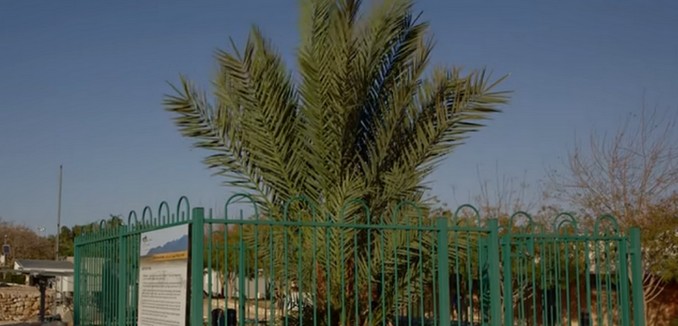Two Israeli researchers have launched an initiative that has transformed the way we understand the meaning of extinction and created a collaborative platform for Arabs and Israelis to explore. In fact, scientists throughout the Middle East, including in Jerusalem, Riyadh and Marrakesh, are looking to J-Date to solve global challenges. This J-Date, however, isn’t the well-known Jewish dating website, but an ancient variety of Judean date palm that vanished two thousand years ago when the Romans drove the ancient Israelites out of their homeland.
In 2004, Sarah Sallon, a Hadassah Medical Center expert in Middle Eastern plants, contemplated an idea that some would call insane: bringing ancient seeds back to life to examine their value in healing human disease. Over the past few decades, a number of reports in scientific journals and popular newspapers have suggested that scientists could germinate ancient seeds. Many were myths. A few are true. No one, however, had ever brought an extinct plant back to life.
In 72 CE, Jewish rebels under siege committed mass suicide at Masada – Herod the Great’s ancient cliff-top fortress – choosing death over Roman bondage. Nearly two thousand years later, in November 1963, a team of archeologists dug through the rubble and found evidence of widespread destruction: shattered frescoes, charred beams, gold coins, bronze arrows, ragged clothing – and containers of ancient seeds.
In 2004 Sallon secured a few seeds from Israel’s Antiquities Authority, then contacted Elaine Solowey, one of the country’s foremost experts in sustainable agriculture. When Sallon broached her resurrection idea, Solowey’s initial response was disbelief, but she agreed to try and hatched a plan to draw the seeds out of dormancy. For “good luck,” Solowey planted the seeds on the Jewish festival of trees, Tu b’Shevat, and about six weeks later, to her astonishment, one of the seeds began to sprout. “It was like a miracle,” she recalls.
Sallon and Solowey called it Methuselah, a biblical figure who lived to be 969 years old. Today, the ten-foot-tall Judean date palm and its long green leaves have become a popular tourist attraction.
The Judean date palm is rich in vitamins, minerals, nutrients and fiber and was one of the most important foods in the ancient Mediterranean. The biblical verse stating that the Land of Israel is a “land flowing with milk and honey” is actually referring to honey from dates, not bees. And according to the Book of Leviticus, the Israelites carried palm tree branches at the Feast of Tabernacles.
As for Methuselah, there is a problem: Because he is a male, he will only produce pollen. His female counterparts produce the fruit. The good news is that Solowey has managed to repeat her success with six more date seeds. In the next few years, she should know if she has successfully planted a female date palm for Methuselah to pollinate.
Experts say that Methuselah’s sex is actually a good thing, because the male plants, as producers of pollen, can impregnate different kinds of date palm trees around the world. Polana Vidyasagar, a date palm specialist and former professor at King Saud University in Riyadh, is very excited about the Judean date palm’s rebirth. He notes that this is “the first time a viable seed has been brought back after two thousand years. It is a novel idea. It opens the gate for other technologies to follow.” Professor Vidyasagar even believes there would be interest throughout the Arab world, particularly in the UAE, in taking Methuselah’s pollen and crossbreeding existing species to see which mix produces the best dates.
Dr. Zaïd Salah Eddine, technical director of the Marrakesh Date Palm Project of Morocco, agrees. “Being able to find a seedling as ancient as the Judean has allowed us to open the previously closed doors, giving a chance to lost genes or traits.”
We can only guess what medicinal benefits the Judean date palm may have. Because scientists haven’t sprouted a female, it’s unclear what their discovery might lead to. But experts say that ancient plant-based remedies could have major implications for modern medicine.
In recent decades, some viruses and bacteria have begun outsmarting steroids and antibiotics. Because desert plants have a unique chemistry that allows them to survive harsh climates, some say they could provide doctors with another way to fight disease. “This,” says Rivka Ofir, a cancer, genetics, and stem-cell expert at Ben-Gurion University, “is one of the future directions for new drugs.”
Saving endangered plants from extinction is critical to the future of humanity. Human beings have used plants throughout history to treat all kinds of illnesses. In fact, over 40 percent of our prescription medications are derived from plant extracts or synthesized plant compounds. When plants face extinction, humanity’s options for discovery and scientific advancement are threatened.
The Judean date palm was extinct for hundreds of years and “has emerged from a time machine,” says Dr. Ori Fragman-Sapir, head scientist of the Jerusalem Botanical Gardens. “This plant symbolizes the archeological and scientific treasures yet to be found in the Land of Israel”
Former New York Times Jerusalem bureau chief Steven Erlanger notes that “Israel is renowned for its agricultural science and research,” and adds: “The Judean date palm is a marvelous example of this kind of ingenuity and persistence.”
[Photo: Israel / YouTube ]




